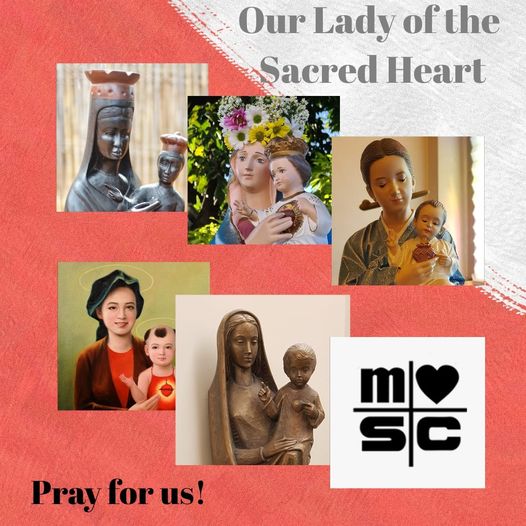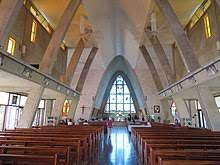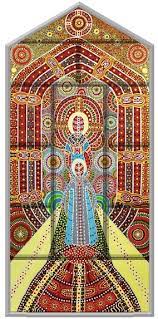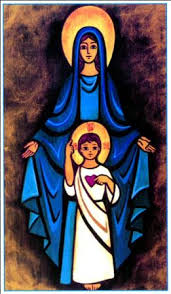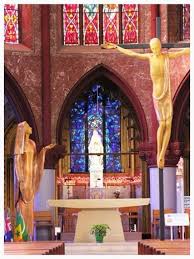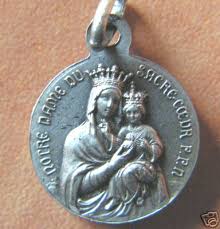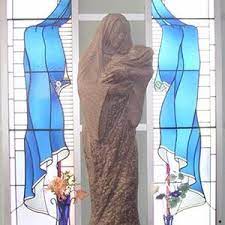|
Our Lady of the Sacred Heart and the Diocese of Darwin
Malcolm Fyfe MSC, Vicar General. |
|
This Saturday, May 29th is the Feast Day of Our Lady of the Sacred Heart, the moveable Feast being now celebrated on the Saturday after Pentecost. This Marian title and the associated devotion have a long-standing connection with our diocese. While the Cathedral has the name St Mary’s Star of the Sea War Memorial Cathedral, there is a prominent side altar dedicated to Our Lady of the Sacred Heart.
Some of you may recall that 12 years ago, the Daughters of Our Lady of the Sacred Heart and the Missionaries of the Sacred Heart commemorated the one hundred and fiftieth anniversary of the title OUR LADY OF THE SACRED HEART, given to Mary by the Founder of our two Religious Congregations, the Venerable Father Jules Chevalier, in the year 1859. It was at the end of the commemorative Mass that Bishop Eugene Hurley blessed the stained-glass window that you can see behind the statue of Our Lady of the Sacred Heart in the Cathedral. Then of course, the Church as well as the College in Alice Springs, both of which are prominent, if not dominant, realities of life in the Alice, are each dedicated to Our Lady of the Sacred Heart. The same is true of the Church and College at Wadeye, the latter having the full title of Our Lady of the Sacred Heart Thamarrurr Catholic College.
Alice Springs and Wadeye, historically and culturally, are two of the more significant features on the Darwin diocese landscape, the Church’s presence there going back to 1929 and 1935 respectively. But the devotion to Our Lady of the Sacred Heart has had a far more widespread significance than the naming and dedicating of diocesan entities in her honour. Because in the life and spirituality of the OLSH Sisters and the MSC Priests and Brothers who worked in the diocese, devotion to Our Lady of the Sacred Heart and devotion to the Sacred Heart overlapped and merged. And the total number of religious from the two Congregations who have worked in the diocese since its inception is astonishing. All told, hundreds from both Congregations, the majority of them now listed in the necrologies, spent a significant number of years working in the diocese.
Let me provide two sample statistics. Writing long back, in 1988, Sister Ann Thomson RSM in her short history of the diocese, entitled “N.T.Dreaming”, was able at that stage to list 41 OLSH Sisters, 15 MSC priests and 21 MSC Brothers who had already worked at Port Keats by then. Equally impressive are the numbers of MSC and OLSH working in the diocese in any given year. Reliable figures for 1975, for instance, show 37 MSC priests and brothers and 29 OLSH Sisters ministering in the diocese. For all of these, spirituality and mission were in large part, inspired and supported by devotion to the Sacred Heart and Our Lady of the Sacred Heart.
To understand this title given to Mary, I once heard it said that it is helpful to read the text from right to left. The important part of this title is the Sacred Heart of Jesus, in other words the devotion is really a Christocentric one. Jesus, as presented to us in all the imagery and symbolism denoting divine love in a human heart, is the centre of attention. Mary is the mother who offers him to us and invites us to discover the compassion, the strength and the constancy of the love of God revealed in her Son. Father Chevalier wanted to honour Mary with a special and relevant title in recognition of favours received through her intercession. Initially, this focus on the efficacy of Mary’s prayers on our behalf dominated his thinking, that is, her ability to obtain graces and help for us from the Sacred Heart. But soon enough, he began to focus on the relationships that supported the effectiveness of Mary’s intercession, relationships between Mary and her Son, between Mary and us. When we look at the statue of Our Lady of the Sacred Heart, and see Mary pointing to the Heart of her Son, Mary reminds us of her unique bond with Jesus. She is the person most closely associated with his Heart and she encourages us to participate in her Son’s mission for the good of humanity. The Gospel accounts of the wedding feast at Cana, as well as of her standing at the foot of the cross, are indicative of her concern for our needs. It was almost a miracle in its own right, how rapidly and how well this Marian invocation was received by Catholics throughout the world.
In the years that followed the inception of the devotion, it became one of the most popular ways of relating to Mary worldwide. It manifested itself in pilgrimages, in confraternities, in a proliferation of art works depicting Mary with her divine Son revealing His Heart and in churches throughout the Catholic world being dedicated to Our Lady of the Sacred Heart. Focusing on one indication of such acceptance, we might note the extensive inculturation of the image of Our Lady of the Sacred Heart in so many different countries. As mentioned above, in 2009, the Daughters of Our Lady of the Sacred Heart and the Missionaries of the Sacred Heart commemorated the one hundred and fiftieth anniversary of the title OUR LADY OF THE SACRED HEART, given to Mary by the Founder of our two Religious Congregations, Father Jules Chevalier. We witnessed a display of an impressive number of images of Our Lady of the Scared Heart created by artists from numerous countries, as imaged through the lenses of their local cultures. This year as we once again celebrate the Feast of Our lady of the Sacred Heart, we might well recall the close association the diocese of Darwin has traditionally had with a devotion that has had an enormous appeal and popularity in Catholic piety, combining as it does, devotion to Mary and to the Sacred Heart.
Postscript from homily, Pat Mara MSC, at Kensington for the feastday. I’ve had the pleasure of working with OLSH sisters in four different countries, Australia, Kiribati, Fiji, and PNG and in each of those countries much more has been done than just scattering flowers. Schools have been built, sick have been healed, poor have been nourished, rejected have been embraced. There has been absolute dedication and heroism displayed by women who have taken on the name Daughter of Our Lady of the Sacred Heart. Some have even made the ultimate sacrifice of giving up their lives in imitation of Jesus, as we heard in the Gospel. In fact, that sacrifice happens on a daily basis. I think of my friend Anne Gardiner who every day gives up her life for the Tiwi people and is an inspiration to thousands. And while there may be just three OLSH left in the NT, there is much to rejoice about and be glad about when we think of what has been achieved.
ln 1988, Sister Ann Thomson RSM in her short history of the diocese, entitled “N.T.Dreaming”, was able at that stage to list 41 OLSH Sisters, who had already worked at Port Keats by then. Equally impressive were the number of OLSH working in the diocese in any given year. Malcolm Fyfe provided reliable figures for 1975, for instance which show 29 OLSH Sisters ministering in the diocese. For all of these women, spirituality and mission were in large part, inspired and supported by devotion to Our Lady of the Sacred Heart. |
